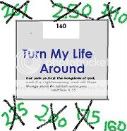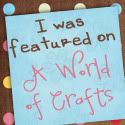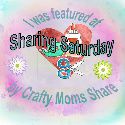We love getting artsy here in our house. Sadly, there isn't near as much time to do so these days. So, when I discover products that can allow us to get creative but are also not very time-intensive, I have to admit, it piques my interest. Such was the case with these materials from ACTÍVA Products. Thanks to the Homeschool Review Crew, we were able to review the Rigid Wrap and CelluClay Quik-Sculpting Kit which allowed us to make a really neat project. There are project ideas included in the box, plus they have a free ebook called ACTÍVA Products' Favorite Sculpture KIDS CRAFTS available on their website. We took their ideas and tweaked them, which tends to happen often in this house.
We were so excited when our package came in the mail. In fact, I think I was more excited than the children.
Let me start by explaining what Rigid Wrap and CelluClay are. Both of these products were included in the Quik-Sculpting Kit, though they can be purchased separately as well.
There were 2 rolls of 4 inch by 5 yard Rigid Wrap. The Rigid Wrap is gauze coated in plaster. Once it is dipped in water, the plaster becomes moist and pliable. It can be used in multiple ways. We chose to use it to wrap a cardboard template, similar to the instructions given for making a butterfly; however, we made fish for an aquarium diorama instead.
Also included was an 8 oz bag of CelluClay which is "Instant Papier Mâché." This is not a powder, which I assumed it was because of the powdery film that was in the box. It appears to be a mixture of plaster and recycled paper bits, which are to be mixed with water to make a clay-type material to mold.
Like the Rigid Wrap, the CelluClay can be used in different ways. We chose to use the idea for the dinosaur that is included in the free ebook, but made starfish to go in our aquarium instead.
Now that I have shared a little bit about each product, let's take a look at how easy they are to use. (Very, very big bonus for this busy homeschooling mom!!)
We started by making some Garibaldi fish and Senorita fish to go in a Kelp Forest aquarium. As I mentioned, there are instructions for making a butterfly using these same techniques. In fact, instructions for the butterfly are on the box, in the included instructions, and in the free ebook.
I found templates online for both of these fish, printed them out, and cut them out of thick cardboard.
I unwrapped one roll of the Rigid Wrap, got a bowl of water ready, and cut the Rigid Wrap into strips.
The children dipped the strips into the water, letting some of the water drip off while running it between their fingers, and then placed it on the cardboard template, wrapping it around, and smoothing the plaster.
This was quite easy to work with. Here you can see Tabitha and Hannah smoothing out the plaster with their fingers.
They wrapped one layer on, then a second layer in a slightly different direction. The Garibaldi fish needed to look "plumper" so we added another piece of cardboard on each side and wrapped more Rigid Wrap around it. Then we added scrunched up Rigid Wrap for the side fins.
Amelia did have some issues with the strips occasionally curling in on themselves and she couldn't unwrap them to use them. Plus there were some sections that didn't want to become pliable. For some reason they remained stiff, even when we left them in the water for a longer period of time. Other than that, we found the Rigid Wrap very easy to work with, much easier than other attempts we have made in the past with other materials to make papier mâché projects. In comparison, this product made very little mess. Yes, the newspaper was needed, but it was easy clean up.
Four fish drying so they can be painted:
Once they were dry, the children painted them, along with a cardboard box for the aquarium. We used bottled acrylic paints, our go-to paint.
The dried Rigid Wrap was a very easy surface to paint on.
Our aquarium partially finished:
I decided we would make starfish to put on the bottom of the aquarium. This was mainly so we could get a chance to use the CelluClay with this project. As I mentioned above, there is a dinosaur project in the ebook that uses CelluClay. I thought it would be fun to use these instructions to make the starfish.
We needed a few more materials to use the CelluClay than we did for the Rigid Wrap. In addition to a cardboard template, the CelluClay and some warm water, we needed wax paper, a plastic zippy bag, plastic wrap and a rolling pin. The instructions in the ebook didn't actually mention the wax paper, but when I was reading up how to use the CelluClay on the website, it stated we needed a Formica or waxed paper working surface. So, to the store to buy wax paper we went.
I found instructions for mixing the CelluClay in the Instructions, Tips and Techniques Sheets under the Learn tab on the ACTÍVA website. There you can find instructions/tips for ten of their products.
I placed approximately half of the enclosed CelluClay in the zippy bag and added some water. I used a little at a time, figuring it would be easier to add additional water, than having to add more CelluClay. Yes, the amounts were given in those sheets I found, but it was for a different amount of CelluClay than what we were using, plus I'm not exactly sure how much we actually used (it looks like about half).
We took turns smooshing it in the bag until the water was incorporated into the product and there were no dry spots left.
It was quite moist, but not too sticky.
I'm not sure why the instructions said to roll it out between two pieces of plastic wrap, but roll it out we did. Though I used the wax paper that was already on the table instead of the plastic wrap. That was a mistake. It got the wax paper way too wet plus it stuck to it. So, instead of saving money and time, I ended up having to put more wax paper down for Tabitha. Oops, next time, we will follow the directions.
As I said, I'm not quite sure what the purpose was of rolling this out, as we just needed to take pieces of it to cover the cardboard starfish.
The children each had their own technique for covering the template.
Tabitha smoothed hers out a lot more than her siblings did. Harold smoothed his out the least, sort of just clumping pieces of CelluClay on. All in all, they turned out okay, but I do wish it wasn't so lumpy.
It is recommended to dry the product on a rack so it can dry evenly.
The next day, the starfish were painted.
One thing I had forgotten to do was make a hole in each fish for the string so they could be hung up. I emailed the company and received a prompt reply, telling me that we could drill a hole in them. I had been concerned that trying to bore a hole would make them crack. We actually don't have a drill, so I used a screwdriver which worked quite well. We did have to add a touch more paint to the holes to cover the plaster that was showing through after I bored the holes. I have to give credit to Tabitha for that ingenious idea.
So, we ended up with eight sea creatures ready to go into their new home.
Our Kelp Forest Aquarium
I have to say, if it hadn't been for this review, I know we wouldn't have come up with such a neat craft. If anything, the fish would have been made out of construction paper and glued on. I have no idea how I would have made 3-D figures without these products. The results are really cool, though a bit lumpy in places, especially the starfish made with the CelluClay. If we had to choose, I would have to say our favorite product is the Rigid Wrap
In order to make this aquarium, we used a little over half of the Rigid Wrap and about half of the CelluClay. So, I will have to think of another project to make with the CelluClay to try it again, to see if we can get our figure will have less lumps. The hubby suggested perhaps a bit more water. I already know what we are going to do with the remainder of the Rigid Wrap. There is an Egyptian Sarcophagus project in the free ebook that will go perfectly with our study of Egypt in the fall.
Regardless of the few issues we had, these products from ACTÍVA are great art materials. They really allow children to make some neat projects. I love the look of some of the other ideas, but a couple of them are a bit more advanced. (I do appreciate that the ebook has the projects leveled: beginner, intermediate, and advanced.)
Don't forget to check out the reviews of my fellow Crew Mates. I can't wait to see what they all made.






















































![[PREMIO2009.png]](https://blogger.googleusercontent.com/img/b/R29vZ2xl/AVvXsEjXD_Gx-wZ9EM5hXKrEYLksEBkYfRQtmb8VDVTDG_yyLggQoFIstZsh4zszdG20KqErZicRzEhiNYLty7j3IMXJYsABqkXjr8pp-ncj71xCbpxlXGbGpZq2fTuDQqq1RMKV4DPcDBnBViA/s1600/PREMIO2009.png)




No comments:
Post a Comment
Thank you for visiting my blog today. I love to read your comments, so please leave me one if you have the time.
Blessings